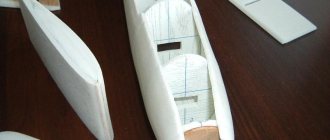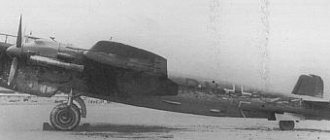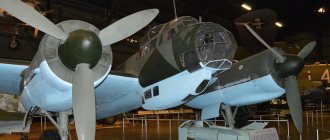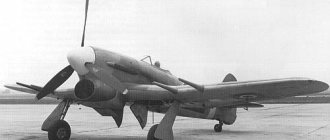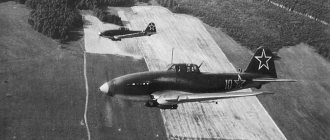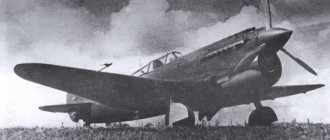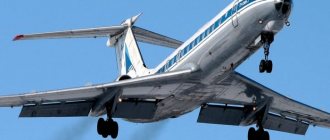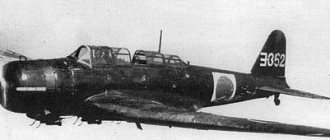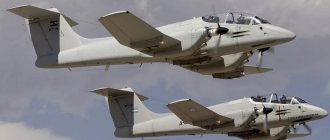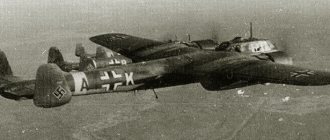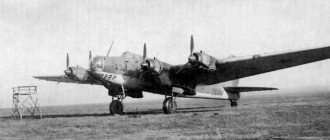Focke-Wulf Fw 190 Dimensions. Engine. Weight. Story. Range of flight
The Focke-Wulf Fw 190, another notable German WWII aircraft well deserving of its place alongside the Messerschmitt Bf 109, was born to replace its predecessor in the Luftwaffe. The total production volume of the Fw 190 was 20,000 units. Development began in 1937. It was carried out, so to speak, in parallel in two directions - using two different power plants: the Daimler-Benz DB 601 in-line engine and the BMW 139 radial engine.
Fw.190B
Tests of the pressurized cabin for the Focke-Wulf were initially carried out on the Fw.190 V12 prototype. Increased pressure inside the cabin was provided by a DVL compressor. We tested the ventilation system, heating the cabin and canopy. Later, three Fw.190 A-3/U7s joined the testing of the pressurized cabin. In March and April 1943, the above-mentioned Fw.190 B-0 series aircraft were sent to Rechlin for testing. On the fourth Fw.190 B-0 (W.Nr 0049), in addition to the pressurized cabin, a GM 1 nitrous oxide injection system with an 85-liter tank was installed. In January 1944, the Fw.190 B-0 (W.Nr 0049) was ready to take off.
Of the proposed first series of aircraft, only one Fw.190 B-1 (W.Nr 0811, BH+CA) will be completed; on August 25, 1943, it took off for the first time. On March 30, 1944, it was sent to Rechlin, by which time the GM-1 system had been dismantled, and an additional 115-liter fuel tank had been installed in place of the nitrous oxide tank.
Focke-Wulf Fw 190 - video
The authorities and designers considered the second option more promising and ultimately opted for a radial engine. The first prototype of the new aircraft took off in June 1939. In 1940, a version of the Focke-Wulf Fw 190A-0, equipped with a new 14-cylinder radial BMW 801, was tested at the airfield in Rechlin. The first large batch of aircraft entered service with the Luftwaffe. , bore the index Fw 190A-1 and were equipped with 1194 kW (1600 hp) BMW 801C engines (by May 1941, the flight units received 100 units of Fw 190A-1). However, despite the fact that the pilots appreciated the flight characteristics of the machine, its simplicity and ease of operation - the Fw 190A-1 was superior to the Spitfire V available to the RAF - they criticized the fighter for its insufficiently powerful armament, which consisted of only four 7.9 mm machine guns.
The designers hastened to correct the mistake. This is how the A-2 modification appeared, equipped with two 20-mm MG FF cannons installed in the root parts of the wings and two MG 17 machine guns, which, however, had to be paid for by some reduction in the maximum speed, which was now 614 km/h. In the A-3 variant, which appeared at the beginning of 1942, the trend of increasing armament continued: the vehicle received two more guns; a more powerful engine was also used - 1269 kW (1700 hp) BMW 801DG. At the same time, the attack aircraft version, A3/U1, appeared. The A-4, which entered service with the Luftwaffe in the fall, reached a speed of 670 km/h thanks to the 1567 kW (2100 hp) BMW 801D-2 engine, boosted by water injection into the suction pipes. The Spitfire IX and the newly appeared Typhoon could not compete with the Fw 190A-4, which as a result cost the RAF 92 fighters that were lost during the Dieppe operation. The Fw 190 was increasingly used as fighter-bombers, armed with bombs, rockets and even torpedoes (Fw 190A-5/U-15), although Focke-Wulf did not forget his main specialty - the interceptor.
The Fw 190 series "B" and "C" were not particularly successful, but the "D" series, especially the D-9 version, equipped with a 1323 kW (1776 hp) in-line Junkers Jumo 213A-1 engine, became the best German fighter, mass produced during the Second World War. The Dora Nine was armed with two 20 mm MG 151 cannons and two 13 mm MG 131 machine guns, which allowed it to surpass the P-51 Mustang in firepower. However, the aircraft that appeared in August 1944 could no longer save the situation and return air supremacy to Germany, which was desperately suffering from a shortage of strategically valuable materials for the military industry and a lack of pilots. The F and G series vehicles were conceived and developed as specialized attack aircraft to directly support the actions of ground units on the battlefield. The latest modification bore the index Ta 152 and was a variant of the high-altitude interceptor Fw 190 series “D” with a larger wingspan, reinforced weapons and a forced-up Yumo 213E/B engine (the maximum speed of this model was 760 km/h at an altitude of 12,500 m), called Ta in honor of its designer Kurt Tank.
Comparison of World War II fighters
Comparison of World War II fighters Dot all the i’s In the Great Patriotic War, we defeated an experienced, organized, brutal and well-armed enemy.
However, throughout the post-war years, our literature practically did not provide an objective analysis of German military equipment, including aviation. When preparing material about the La-5 and FW 190 fighters, I could not stop at just a brief description of the German aircraft, because it was one of our main opponents in the skies of war, truly strong and dangerous. But it seems to me that a whole generation of people who are more or less interested in aviation are accustomed to thinking in certain stereotypes. So, without any doubt, we call the Spitfire the best English fighter of the Second World War and disparage the Hurricane. The American Airacobra has become almost our favorite aircraft, and at the same time we know almost nothing about the Hellcat. We are accustomed to respecting the Mustang and look at the fat, ugly Thunderbolt with obvious misunderstanding, without even thinking about why this particular fighter was the most popular aircraft in the US Air Force during the war.
There is nothing surprising in the fact that we consider the Yak-3 the best fighter in the world. An equally stereotypical opinion exists regarding German aircraft, because in almost all books we read the same words. Let us open, for example, the famous book by aircraft designer A. Yakovlev “Soviet Aircraft”. He writes: “Our main fighter aircraft, the Yak and La, in terms of their combat qualities throughout the war, had an advantage over German machines of similar purpose - the Me 109 and FW 190.”
In addition, the FW 190 fighter is often shown as a clumsy, overweight aircraft that cannot be compared with Soviet and foreign aircraft. Well, how can you doubt this? And suddenly, a quote from the book of English researchers D. Richards and H. Sanders “The British Air Force in the Second World War 1939-1945” sounds dissonant.
“The Spitfire fighter in all its variants was little superior (if it had any superiority at all) in its flight-tactical characteristics to the best German fighter Focke-Wulf 190.” Quite an interesting statement, isn't it? So, in order to understand the issue more clearly, let's take a closer look at the flight performance characteristics of the Fokker in comparison with other aircraft, and above all with the La-5 fighter. Moreover, these aircraft not only constantly engaged in air battles with each other, but were also more or less close in size, flight weight and power plant power.
As you know, the main criterion characterizing the perfection of any aircraft is its maximum flight speed. Let's see who had the advantage. Let's start with 1942 (from the moment these aircraft appeared at the front). At this time, the maximum flight speed of the La-5 was 509 km/h at the ground and 580 km/h at an altitude of 6000 m. For the German aircraft, these figures were 510 and 610 km/h, respectively (data from the results of flight tests of the captured FW 190A fighter -4 at nominal engine operating mode). A year later, improved La-5FN and FW 190 aircraft of the A-5, A-8 and A-4 series appeared in the battles on the Kursk Bulge, many of which were equipped with the MW-50 system for injecting a water-methanol mixture into the engine cylinders. The maximum flight speeds of these machines were: for the FW 190 - 571 km/h at the ground and 654 km/h at an altitude of 6000 m. Without the use of the MW-50 system, the maximum speed was 10 km/h less. Thus, Soviet fighters had some advantage in speed at altitudes below 4000 m, where, as a rule, air battles were fought. However, there are certain subtleties here too. Thus, in the book “Wings of Victory” by A. Shakhurin (who was at that time the People’s Commissar of the aviation industry), pilots’ statements are given about the comparison of the La-5 and FW 190 fighters. “Horizontally, the La-5FN is slow, but it catches up with the FW 190, then the candles give up and The FW 190 is slowly going away."
In this regard, the pilots repeatedly turned to the designers with a request to add another 20-30 km/h to the aircraft. In 1944, improved La-7 fighters began to arrive at the front, with a maximum flight speed of 680 km/h. However, here too, for the sake of objectivity, it must be compared with the new version of the Focke-Wulf - the FW 190D fighter, also released in 1944 and which appeared at the front. The flight speed of this aircraft reached 685 km/h. Speaking about the value of the maximum flight speed, it should be noted that in air battles they were never achieved, since the aircraft were constantly maneuvering, many of them had externally mounted weapons, worn-out engines, patches on damaged areas, removed or torn landing gear doors, which greatly reduced flight speed.
From the history of air combat it is known that pilots, in order to increase flight speed, tried to attack the enemy from above, gaining it in a dive. In this regard, the Focke-Wulf-Fam had no equal (at least on the Soviet-German front). Our pilots constantly noted the fact that the Germans often evaded pursuit by diving towards the ground (if altitude allowed). Moreover, even in a fairly flat dive with an angle of thirty degrees, the FW 190 accelerated to a speed of 1045 km/h (one of the evidence of its good aerodynamics). Of all the Allied aircraft, only the Mustang and Thunderbolt could catch up with the Fokker while descending. But in terms of maneuverability characteristics in close air combat, the FW 190 was somewhat inferior to our fighters.
As is known, horizontal maneuverability (turn radius and turn time) is directly proportional to the specific wing load. For FW 190 it was quite high and amounted, depending on the modification, 210-240 kg/m2. At the same time, for all Lavochkin fighters it did not exceed 190 kg/m2. It is not surprising that the turn time of the La-5 and La-7 was 3-4 seconds less than that of the Focke-Wulf (19 instead of 22 seconds). Yakovlev's fighters had even better horizontal maneuverability.
The British Spitfire V and Spitfire IX fighters had the highest horizontal maneuverability among all Allied aircraft, since their specific wing load did not exceed 150 kg/m2. It would seem that these highly maneuverable high-speed fighters, which had proven their complete superiority over the German Messerschmitt Bf 109 fighters, should have had even greater advantages over the heavy Focke-Wulfs. However, this just did not happen. It was quite difficult for the Spitfire pilots to shoot down the FW 190. The thing is that before making a turn, any aircraft must make a roll, that is, make a turn around the longitudinal axis. The roll rate of all aircraft was different. It depends on the efficiency of the ailerons, the moment of inertia of the aircraft and the wing span. Moreover, as the span increases, the roll speed sharply decreases. In this regard, the larger Spitfire was inferior to the Focke-Wulf. The German fighter took a turn faster, and when the pursuing Spitfire began to overtake it, the Focke-Wulf pilot quickly moved the car from the right turn to the left or vice versa and again escaped from the attack. True, the above does not mean that the FW 190 turned out to be more maneuverable. In the same way, the German pilots could not do anything with the Spitfire, which was escaping fire in a steep turn. In a word, for the British the German fighter turned out to be a “tough nut to crack.” It is enough to quote the words of F. Lloyd, one of the famous English specialists in the field of aviation, which he said at the end of 1943.
“If the British aircraft do not match the FW 190 in this respect (meaning the high roll rate), then it will always be able to elude attack.” By the way, the cut ends of the wings on some modifications of the Spitfires can apparently be explained by the desire to increase the roll rate. As for Soviet fighters, they were much better in this regard, since they had a smaller wing span, as well as a small moment of inertia - after all, the guns on Soviet aircraft were located in the fuselage, and not in the wing, like all British aircraft.
A few words about vertical maneuverability. Of course, the rate of climb of the FW 190 was not very high - 12-14 m/sec, while for other fighters it was 15-20 m/sec, and naturally, in maneuverable air combat, the La-5 fighters had complete superiority. However, the following point must be taken into account. It turns out that the rate of climb when performing a vertical maneuver depends not only on the specific power load (the ratio of the aircraft’s mass to the power of its power plant - for the La-5 this value was approximately 2.3 kg/hp, and for the FW 190 - 2, 5 kg/hp), but also on the ratio of the flight mass to the total aerodynamic resistance of the aircraft. When an airplane begins to climb steeply after a dive or after flying at high speed, the first part of the climb occurs due to its inertia. In other words, the greater the mass of the aircraft and the flight speed and the lower its resistance, the faster the aircraft will gain altitude at the first moment. And in this regard, the German pilots had a certain advantage over the enemy. In any case, their first attack and exit from it were always swift.
Getting involved in a close maneuverable air battle was considered inappropriate, since during sharp maneuvering the heavy Focke-Wulf quickly lost speed and its rate of climb dropped sharply. In addition, the practice of combat operations showed that in group air battles the advantages of some aircraft over others could not be fully demonstrated, since the pursuers were often themselves subject to enemy attacks. By the way, in memoir-type literature, German pilots who evaded air combat are called cowardly. However, they had their own calculations in this. The FW 190 could not conduct a maneuverable battle with our fighters at low speed, and the Germans, naturally, did not get involved in such battles, especially since a maneuverable battle is, in general, defensive, not offensive. During the war, the Germans, on the contrary, preferred the “hunter” tactics. And here we come to the most interesting thing...
It turns out that we and the Germans had a different approach to the actions of fighter aircraft. The main task facing Soviet pilots was to cover ground forces from enemy aircraft and escort their bombers. This alone forced them to conduct mainly defensive battles with German fighters. At the same time, German fighter pilots had another primary task - the destruction of enemy aircraft, and the ground forces had to rely more on their own air defense systems, which they had in abundance. With this approach, German pilots more often used free-hunting tactics and chose bomber and attack aircraft as targets. It is not surprising that many of them had 100, 200 and even 300 or more air victories.
As for the FW 190 fighter, it was quite well suited for such purposes. The FW 190 was reliably protected from the fire of defensive weapons of bombers (and these were, as a rule, machine guns). And the powerful 20-mm MG151/20 cannons made it possible to hit targets at a slightly greater range than the machine guns on bomb carriers.
Special mention must be made about the armament of the FW 190 aircraft. According to such a criterion as the weight of a minute salvo, vehicles even of the first modifications - A-3 or A-4 - were almost twice as large as the La-5. Judge for yourself: this value was 275 kg/min for the FW 190, 150 kg/min for the La-5, 202 kg/min for the Spitfire IX and 160 for the Airacobra (version with a 37 mm cannon). kg/min. After replacing machine guns and wing cannons on the Focke-Wulf with more advanced ones, the weight of a minute salvo increased to 350 kg/min, and the FW 190 became the most powerful single-engine fighter in the world. True, the American Thunderbolt had the same weight per minute salvo, but it was armed only with machine guns, and the destructive effect of the bullets was lower than that of an exploding shell. When, at the end of the war, the latest 30-mm MK108 cannons, whose projectile mass was three times greater than that of the 20-mm MG 151 cannons, began to be installed on FW 190 fighters, the weight of a minute salvo increased to almost 600 kg/min. For comparison, for the heavy twin-engine Mosquito fighter, equipped with four cannons and four machine guns, this value was 345 kg/min. Thus, even without taking into account the use of missile weapons, FW 190 fighters posed a serious danger not only to front-line, but also heavy strategic bombers.
Summarizing the results of the analysis, it should be noted that, on the one hand, the FW 190, of course, is not the best fighter in the world (as Hitler’s propaganda imagined it), since it did not have any advantage in air battles with Soviet fighters, but on the other On the other hand, the strengths of this truly formidable fighting machine should not be underestimated.
And finally the last thing. At the end of the war, German aviation, although it posed a certain danger, did not conduct active combat operations. The latest modifications of the FW 190 aircraft that appeared in the air were successfully shot down by Soviet, British and American fighter pilots. This did not mean that German aircraft were worse than enemy aircraft. On the contrary, at this time the Germans had really good cars. By the way, when at the beginning of April 1945, advanced British units captured Professor K. Tank himself, it was clear from his testimony that German designers had made significant progress.
However, in conditions of complete air supremacy of Allied aviation, no most advanced aircraft could change the nature of the war. German fighters only defended themselves in extremely unfavorable conditions. In addition, there was practically no one to fly them, since the entire flower of German fighter aviation was “laid to the bone” on the Eastern Front in fierce battles with Soviet pilots. And this, of course, is precisely what should be considered the main and decisive reason for the complete defeat of the Luftwaffe.
Victor Bakursky “Wings of the Motherland” No. 5 1991
RSS feed of comments for this entry Refresh list of commentsleave a comment |
Performance characteristics of the Focke-Wulf Fw 190 D-9
— Chief designer: Kurt Tank
Crew of a Focke-Wulf Fw 190
— 1 pilot
Dimensions of the Focke-Wulf Fw 190
— Length, m: 10.20 — Wing span, m: 10.50 — Height, m: 3.35 — Wing area, m²: 18.30 — Wing load, kg/m²: 238
Weight Focke-Wulf Fw 190
— Empty weight, kg: 3490 — Curb weight, kg: 4350 — Maximum take-off weight, kg: 4840
Engine Focke-Wulf Fw 190
— 1× Jumo 213A-1 — Power, kW (hp): 1287 (1750), 1544 (2100) (afterburner) — Thrust-to-weight ratio, kW/kg: 0.30-0.35
Speed Focke-Wulf Fw 190
— Maximum speed at altitude, km/h / m: 685 / 6600 (afterburner), 710 / 11 300 (dive) — Rate of climb, m/s: 17 — Takeoff run, m: 450
Flight range of the Focke-Wulf Fw 190
— 835 km
Service ceiling Focke-Wulf Fw 190
— 12,000 meters
Armament of the Focke-Wulf Fw 190
— Machine gun-cannon: 2x13 mm MG-131, 2x20 mm MG 151 — Bomb: 1x500 kg SC500
Other modifications
Over Dieppe on July 20, 1942, a new modification of the “vulture” - Fw 190A4 - first appeared. The characteristics of this car completely eclipsed those of the new Spitfire DC, and the speed was 665 km/h. The appearance of the A-4/U-8 variant marked the beginning of bombing attacks in September 1942. These vehicles entered the fighter units of JG 2 and JG 26. Retaining the MG 151 root cannons and fuselage machine guns, the vehicle could carry one 500 kg SC500 bomb under the fuselage , as well as one 300-liter drop tank under each wing. The raids carried out in the autumn and winter of 1942, which involved no more than a few dozen German aircraft, provoked a completely disproportionate response from the Royal Air Force. The Germans used “free hunting” tactics, attacking cities, airfields, and trains. They usually approached in pairs just above the water, so as not to be detected by radar. This situation led to the creation of an almost continuous patrol service carried out by Spitfires and Typhoons, but only 1 in 200 missions resulted in combat. In response to approximately 360 German fighter-bomber missions, the RAF flew over 52,000 patrol missions.
Mark on history
The Focke-Wulf 189 turned out to be so good that it served a long and fruitful service on all fronts. The last aircraft of this type was shot down on May 8, 1945, at the very end of World War II.
Proof of this is that the superpowers involved in the war devoted a lot of effort and money to creating aircraft like the FW.189. But, perhaps, at that time no one except the Germans managed to create such a successful reconnaissance and fire spotter.
It is enough to note that the role of reconnaissance aircraft in the Allied air forces was performed by mass-produced vehicles converted for these purposes.
In the USSR, for example, under the intelligence officers of the 30s, at the time of the war there were no specialized reconnaissance spotters.
As a result, the correction tasks were solved by the Il-2K, and the long-range reconnaissance tasks were solved by modifications of serial vehicles equipped with photographic equipment, such as the Pe-2R, Yak-9R, as well as spitfire reconnaissance modifications supplied under Lend-Lease. The same situation has developed in the West.
So the famous writer Exupery was shot down on a reconnaissance modification of the R-38 aircraft.
It is clear that these vehicles could not fully fulfill the role of reconnaissance and spotter.
This emphasizes the professionalism of German engineers who created a vehicle with high performance and combat characteristics. In addition, the “frame” served as the basis for the development of the post-war reconnaissance aircraft of the USSR by the Sukhoi Design Bureau, called the Su-12.
Fw.190D
Focke-Wulf Fw.190 D-9 with ETC 71 bomb racks
The fighter version with the Jumo 213 engine was designated Fw.190D. Unlike the two experimental versions Fw.190B and Fw.190C, Dora was mass-produced. The Fw.190D fighter was initially designed to be equipped with the Jumo 213 engine (an inverted V-shaped 12-cylinder liquid-cooled piston engine, a further development of the Jumo 211 engine). Unlike its predecessor, Jumo 213 was smaller in size but had more power...Read More
Design
The Focke-Wulf 189 was a technologically advanced aircraft of its time. Light metal alloys were used in the production of the machine. The airframe, tail unit, and engine nacelles were made of metal. Only the rudders and ailerons were covered with canvas, but this did not in the least prevent the FW.189 from remaining a very durable machine.
A distinctive feature of the reconnaissance aircraft was the almost completely glassed cabin in which the crew was located.
Built on the principle of installing removable panels of flat glass, it provided sufficient visibility for reconnaissance.
The pilot's seat was strongly shifted to the left side, since on the right hand, slightly behind, there was a place for the navigator-radio operator. He could drop bombs on enemy positions using an optical sight.
The only drawback for the navigator was the seat without a backrest, so sitting for a long time was quite problematic. In addition, when repelling enemy attacks, the navigator-radio operator was assigned the functions of a gunner, since he could fire from the upper firing point of the aircraft.
In the rear of the cabin, there was a place on the mattress for the gunner-flight mechanic. He was responsible for protecting the rear hemisphere from attacks by enemy fighters.
Soviet pilots learned to effectively fight the FW.189 only when they realized that they needed to fire into the cockpit: the glass panels could not properly protect the crew.
The cabin was most vulnerable when attacked from below.
The plane's landing gear was retracted immediately after takeoff. The two front wheels were hydraulically folded and retracted into the engine nacelles. The landing gear niches were closed with flaps for better aerodynamics of the airframe. The rear wheel went to the left and was located on the horizontal tail section.
The aircraft were equipped with 12-cylinder V-shaped engines of the Argus brand. Air cooling, developed power at takeoff is 465 horsepower. In flight, the engines developed a power of 380 horsepower.
Behind each of the engines there were oil (19 liters) and fuel tanks (220 liters) protected by fire barriers. The most important characteristic of the new reconnaissance aircraft was the ability to rise to high altitudes.
The stated figures were 7300 meters, but if necessary the plane could rise to 8000 meters, so the cabin was supplied with an oxygen system. Oxygen cylinders were located in the wing behind the machine guns.
Armament of FW.189:
- MG-15 machine guns of 7.92 mm caliber in lens mounts. The firing points were located on top of the central gondola and behind it. The rear hemisphere was especially well protected, so turning the aircraft away from a frontal attack could be considered the best defensive position. An Ikaria turret was installed in the rear of the cockpit, with electrical guidance, but aiming was carried out manually.
- Two MG-17 machine guns, chambered for 7.92 mm, were mounted motionless in the center section. They were used to support ground forces and in air combat.
- Focke-Wulf.189 could carry 4 bombs weighing up to 50 kilograms. It is known that the plane could be used as a bomber, so in addition to bombs, pouring devices (for example, for a chemical attack) or containers with smoke bombs could be placed in special beam holders. The FV.190 could also carry two 100 kg caliber bombs.
With the FW.189-A2, the defensive armament consisted of more advanced twin machine guns MG.81Z; they had a higher rate of fire than the MG15 and significantly increased the spotter’s defense capability against fighter attacks.
The FW.189 was primarily developed for use as a reconnaissance and spotter. For this reason, a number of photographic equipment for aerial photography could be installed in the interior of the central gondola: Rb 20/30, Rb 50/30. Rb 21/18 or Rb 15/8. It was not uncommon for one of the crew members to operate a Hk 17.5 or Hk 19 hand-held camera.
Modifications of the "flying eye" and combat use
For that time, the Focke-Wulf .189 aircraft was a successful model of reconnaissance aircraft. The Germans combined many successful solutions in one vehicle, which ensured high survivability and efficiency of the reconnaissance aircraft.
Thus, many experts agree that the FW.189 had a number of unique advantages that made it head and shoulders above its competitors:
- the two-boom design of the aircraft made it possible to achieve good visibility and maneuverability, in addition, the FV.189 could “hang” over positions for quite a long time;
- advanced glazing ensured the operation of photographic equipment and crew;
- Focke-Wulfs are easy to assemble, and easy to operate and maintain;
- The FW.189 could patrol over enemy positions for a long time, correcting artillery fire or recording the results of an air raid;
- The FW.189 flew even in difficult weather conditions; the large glass area of the cockpit helped to maintain orientation even in low visibility.
However, by the end of 1941 it was decided to strengthen the first models of the aircraft with additional weapons. Production samples of the FW.189 A-2 began to arrive at the front. They were distinguished by MG-81Z machine guns in the rear of the cabin.
For a short time in May 1943, a squadron of reconnaissance aircraft was deployed to track partisan detachments deep in the rear of Nazi formations. It is worth admitting that they coped with their task very well.
But they were soon transferred again to the eastern front. In the Battle of Stalingrad, they circled around the positions of Soviet troops around the clock and provided command with timely intelligence data, adjusted artillery fire and recorded the results of the actions of ground units and Luftwaffe groups.
In the early years of the Great Patriotic War, German aircraft ruled the skies on the eastern front.
Cases of losses of FW.189 scouts were isolated. But by the end of the war, the German command realized an obvious fact: the Focke-Wulfs are effective only if the covering aircraft have air supremacy.
When the Soviet side began to outnumber the Luftwaffe fighter groups numerically and qualitatively, reconnaissance losses reached staggering numbers. It is known that in some regiments, out of dozens of vehicles, only a few remained.
To reduce losses, the FW.189 mastered the role of a night reconnaissance aircraft. For this purpose, special light-sensitive equipment and light bombs were used.
It was possible to install a radar on the Focke-Wulf 189, and this was used to create a night fighter that could effectively operate against the famous “night witches” - night bomber regiments on light bombers LNB-2 (Po-2), which caused significant damage to the Wehrmacht.
But the life of the successful scout was obviously coming to an end.
Soviet fighters regarded the Focke-Wulfs as target number one, so they devoted all their efforts to destroying them. This led to the rapid replacement of the FW.189 with new aircraft.
Fw.190S
Focke-Wulf Fw.190S
There was a growing shortage of experienced pilots who had to fight against Allied bombers with Fw.190 fighters. Units armed with Junkers Ju.87 and Messerschmitt Bf.110 aircraft were re-equipped with attack versions of the Focke-Wulf. These reasons, as well as large losses of personnel, led to an increase in demand for Fw.190 pilot training. Flight schools could no longer meet the demand for new pilots. It was decided to develop a two-seat training version of the Fw.190S. Most of the created training Focke-Wulfs were converted from serial Fw.190 A-5 (into Fw.190 S-5) and Fw.190 A-8 (into Fw.190 S-8).
Fw.190F
Focke-Wulf Fw.190 F-8
The Focke-Wulf Fw.190F attack aircraft were created on the basis of various modifications of the Fw.190A fighter. They were distinguished by enhanced armor protection and more powerful missile and bomb weapons. The armor protected the lower part of the fuel tanks, engine and chassis. An increase in the aircraft's take-off weight required a reduction in the number of small arms.
